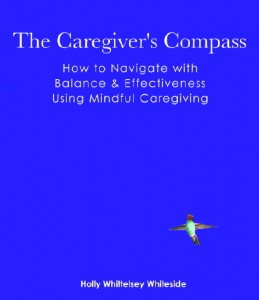 You’re a caregiver. Now what?
You’re a caregiver. Now what?
The Caregiver’s Compass: How to Navigate with Balance & Effectiveness Using Mindful Caregiving will give you direction as you navigate the road ahead.
Organized in two parts and seven chapters, the first part overviews three mindful caregiving principles—being present, shifting communications, and welcoming change. The second part applies these principles to three parts of a caregiver’s experience—emotions, well-being, and effectiveness.
Author, Holly Whittelsey Whiteside applies fifteen years of life-coaching principles to caregiving, while illustrating with excerpts from her journal as decade-long caregiver to her mother.
Throughout the book, she emphasizes being present and self-aware in order to be a mindful caregiver. For example, if we stop and fully listen to our care recipient we can succeed in fostering a real connection, which will improve how we give care and how our care recipient responds.
After we grow in our own self-awareness, Whiteside encourages us to understand how it is to live in our care recipient’s world. This will impact how we think and speak about our caregiving experiences. How we label our experience will determine how we experience it. Instead of thinking, He’s doing this on purpose, we will empower ourselves to change how we approach caregiving. Sometimes, she adds, we need to let things unfold. Whatever approach we choose will impact our well-being.
Whiteside describes caregiving as concentrated living.
As caregivers, we can choose to be burdened by the weight of our daily responsibilities or we can choose to find or create moments of happiness. Holly writes of how she found ways to laugh on demand. For example, while running errands she’d sing old love songs to herself in the voice of Elmer Fudd. After she sang Fwy me to de moooon, she writes, “I laughed till I cwied and almost went off the woad.”
The Caregiver’s Compass gives us the unprecedented opportunity to know ourselves better, to sometimes let go and let things be, without needing to meditate on a mountaintop. Whiteside includes a helpful tool, Housecleaning for Self-Connection Matrix, to enable us to better know our needs balanced with the needs of our care recipient.
Whiteside’s decision to care for her mother was not easy. Coming from a self-described difficult childhood, she writes (paraphrased): To care for Mom, I had to care about her. These two words bear significance for many challenged caregivers. Imagine how differently you’ll care for someone, once you decide to care about him/her. Her mom lived independently until she moved into an assisted living community.
The Caregiver’s Compass applies to other aspects of our lives as well. Whatever you endeavor that may cause uncertainty and with it a worrisome fear; such as deciding to retire, move, take on a new job, learn a new skill, Whiteside explains, takes us out of the present moment into a future that has not yet happened. She provides exercises (as she does after every principle) to identify our fears and then to let go; encouraging us to accept some future unknowns.
Caregivers should read, digest, and apply one principle before applying the next one. In about one month, a busy and overwhelmed caregiver will receive daily coaching to transform his/her experience. Support group facilitators can guide support group members in applying one principle at a time.
Reviewed by Brenda Avadian, MA on June 9, 2010
Editor, The Caregiver’s Voice Book Review














